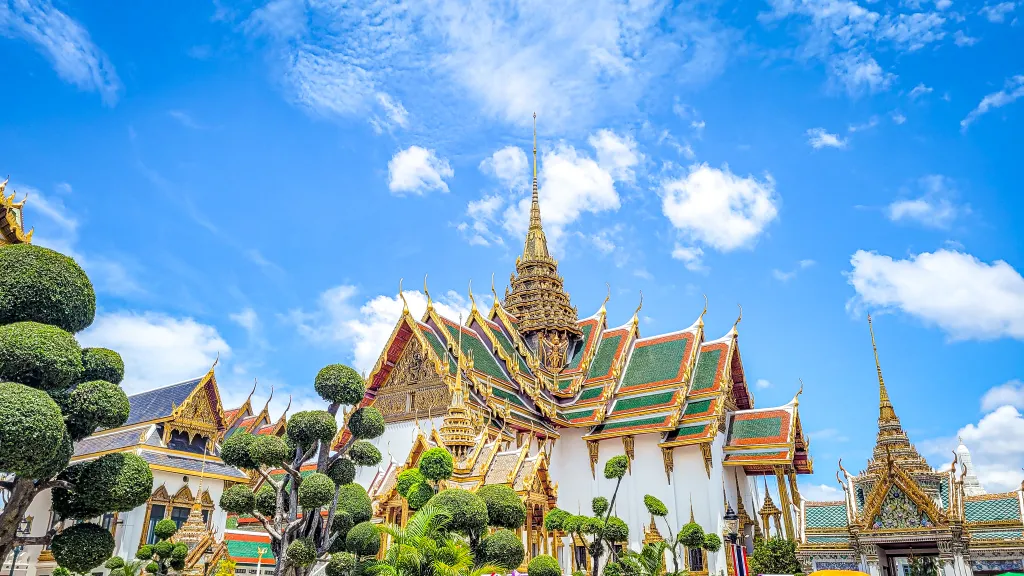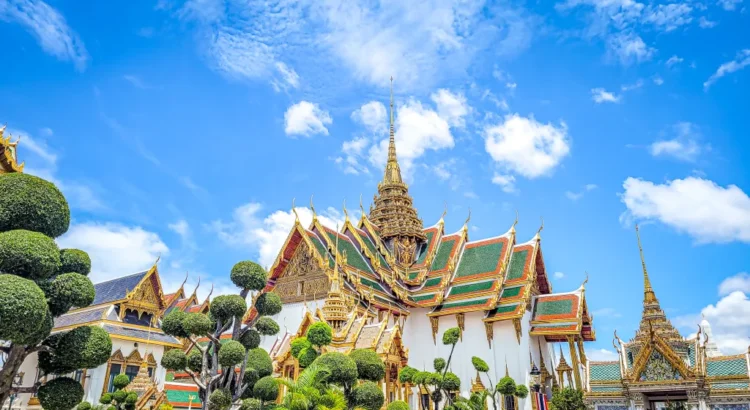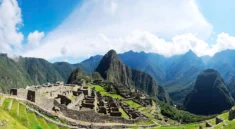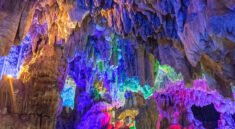
In the heart of Bangkok, amid the bustle of modern Thailand, lies a sanctuary of spiritual grandeur and timeless artistry: Wat Pho, the Temple of the Reclining Buddha. As Thailand’s oldest and one of its most revered temple complexes, Wat Pho is more than just a religious site—it is a living repository of Thai heritage, architecture, medicine, and philosophy. The highlight of this sacred site is undoubtedly the 46-meter long Reclining Buddha, a golden marvel that captures the essence of Buddhist reverence and the elegance of traditional Thai craftsmanship.
From peaceful courtyards and symmetrical pagodas to intricately decorated chapels and serene monastic life, Wat Pho invites visitors into a world that transcends time. This is where ancient wisdom meets spiritual beauty, where the soul finds both enlightenment and awe. Whether you’re a history enthusiast, a seeker of peace, or a first-time traveler to Thailand, a visit to Wat Pho is an essential journey into the heart of Thai culture and Buddhism.
A Legacy That Dates Back Centuries
Wat Pho, officially known as Wat Phra Chetuphon Wimon Mangkhalaram Rajwaramahawihan, is considered the oldest temple complex in Bangkok. Though the temple’s origins trace back to the 16th century during the Ayutthaya period, its current grandeur is attributed to the visionary restoration and expansion initiated by King Rama I in the late 18th century. Later, King Rama III further enriched the complex by adding the enormous Reclining Buddha and developing the temple as a center of education and traditional medicine.
Strategically located adjacent to the Grand Palace, Wat Pho spans over 80,000 square meters, making it one of the largest temples in Thailand. Its history is interwoven with that of the Chakri Dynasty, and it remains a first-grade royal temple, under royal patronage and national protection.
The Reclining Buddha: A Symbol of Nirvana
The awe-inspiring centerpiece of Wat Pho is the Reclining Buddha, housed within the Phra Viharn, a long hall specifically built to accommodate this massive icon. Measuring 46 meters in length and 15 meters in height, the statue portrays Buddha at the moment of entering Nirvana, the final release from the cycle of death and rebirth.
What makes this statue unforgettable is not just its immense scale, but its exquisite detail. The figure is entirely covered in gold leaf, radiating a divine glow that fills the hall. The Buddha’s face exudes serene composure, with mother-of-pearl inlays decorating the eyes and soles of the feet. These feet alone span over 5 meters, and they are adorned with 108 intricate symbols representing the various attributes of the Buddha.
Surrounding the reclining figure are 108 bronze bowls, into which visitors drop coins for good luck and merit-making, a tradition deeply rooted in Thai Buddhist practices.
Architecture That Reflects Thai Identity
Wat Pho’s architectural style reflects a harmonious blend of Ayutthaya and early Rattanakosin design, infused with Chinese decorative elements introduced during trade and cultural exchanges. The complex is enclosed within whitewashed walls, with four main chapels (viharns), a central bot (ordination hall), and a maze of cloisters, courtyards, pavilions, and chedis (stupas).
Highlights include:
- Phra Ubosot (Ordination Hall): The spiritual heart of the temple, housing a magnificent seated Buddha surrounded by traditional murals depicting the Jataka tales and scenes from Buddhist cosmology.
- Chedi of the Four Kings: These massive, colorfully-tiled stupas honor the first four Chakri kings. Each is unique in design, adorned with glazed ceramic mosaics, lotus motifs, and intricate patterns.
- Courtyards with Giants and Guardians: Statues of Chinese warriors and mythical guardians line entrances and protect sacred spaces, reflecting the cultural fusion and symbolism deeply embedded in Thai spirituality.
A Sanctuary of Serenity
Despite its grandeur and popularity, Wat Pho remains a place of quiet contemplation and spiritual practice. Its spacious layout is dotted with tranquil courtyards, shaded walkways, lotus ponds, and blooming frangipani trees. Monks in saffron robes can be seen going about their daily routines—studying, chanting, and meditating—offering visitors a glimpse into the rhythms of monastic life.
The temple complex invites wandering. You can sit under a tree, watch as birds flit through the eaves, or simply absorb the calm energy that permeates the air. Unlike the often-crowded Grand Palace, Wat Pho offers moments of peace, ideal for introspection or quiet photography.
The Birthplace of Thai Traditional Medicine and Massage
Wat Pho is not only a religious sanctuary—it is also regarded as Thailand’s first public university. During the reign of Rama III, the temple became a center of learning for traditional Thai medicine, massage, and astrology. Even today, its legacy lives on.
On the temple grounds, you will find the Wat Pho Thai Traditional Medical School, which continues to teach and practice Thai massage therapy. Many of the ancient teachings have been inscribed on stone plaques and walls throughout the temple, depicting acupressure points, herbal treatments, and yoga-like postures.
Visitors can even book a massage session within the complex—either a traditional Thai massage, foot reflexology, or a herbal therapy session—offering not just relaxation but a direct encounter with centuries-old healing wisdom.
A Journey Through Symbolism and Spiritual Insight
Every element of Wat Pho is steeped in symbolism, reflecting the spiritual principles of Buddhism and the cosmology of Thai belief systems:
- The four chedis represent the stability and continuity of the Thai monarchy.
- The murals inside the chapels narrate moral tales and parables meant to guide ethical living.
- The Reclining Buddha’s posture signifies his transition into Nirvana, urging all beings to seek release from suffering.
- The 108 symbols on the feet embody completeness and perfection in Buddhist philosophy.
Even the layout of the complex—divided into the monastic and sacred areas—mirrors the dual nature of spiritual pursuit: inner meditation and outer ritual.
When to Visit and How to Prepare
Wat Pho is open daily from 8:00 AM to 6:30 PM, and mornings are generally quieter and cooler, allowing for a more contemplative experience.
Practical tips:
- Dress Modestly: As a sacred site, visitors must cover shoulders and knees. Scarves and sarongs can be borrowed at the entrance if needed.
- Entry Fee: Currently around 200 Thai Baht for foreigners, which includes a bottle of water.
- Guides and Audio Tours: Available in multiple languages to enhance your understanding of the complex.
- Combine with Grand Palace Visit: Located just a short walk away, Wat Pho is ideally paired with a visit to the Grand Palace and Wat Arun across the river.
Local Experiences Nearby
Beyond the temple walls, the surrounding Old City (Rattanakosin Island) offers rich cultural encounters:
- Tha Tien Market: A riverside market with traditional snacks, dried seafood, and local life.
- Chao Phraya River Ferry: A scenic and inexpensive way to see temples, palaces, and modern Bangkok from the water.
- Street Food and Cafés: From mango sticky rice and pad thai to artisan coffee shops, the neighborhood offers a feast for the senses.
Why Wat Pho Belongs on Every Traveler’s List
Wat Pho is not just a tourist site—it is a living cultural monument, a tranquil refuge, and a gateway into the heart of Thai identity. It offers the grandeur of history and the intimacy of spiritual reflection, the marvel of architectural beauty and the simplicity of quiet moments under a Bodhi tree.
In an era of fast-paced travel and digital distractions, Wat Pho stands as a reminder of what endures: faith, peace, artistry, and wisdom. Whether you marvel at the Reclining Buddha’s sheer scale, learn about ancient medical traditions, or simply enjoy the silence of a quiet courtyard, your time at Wat Pho will leave a deep and lasting impression.




